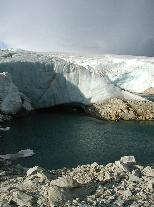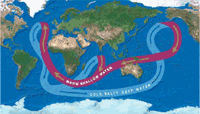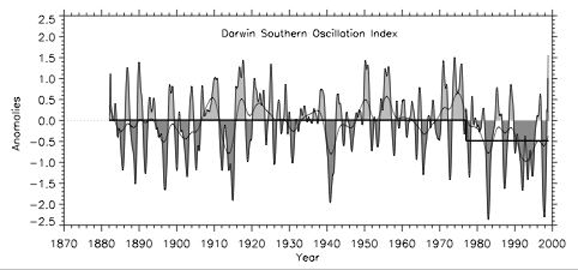 |
|
LAMONT-DOHERTY EARTH OBSERVATORY THE EARTH INSTITUTE AT COLUMBIA UNIVERSITY |
||
| Abrupt Climate Change | ||
| LDEO | ||
| Home | ||
| Divisions | ||
| LDEO Search | ||
| Abrupt CC | ||
| Home | ||
| Q&A | ||
| Contacts | ||
| Research | ||
| Links |
|
back to Q&A The 76/77 climate shift Between 1976 and 1977, the Tropical Pacific (the performing stage of the El Niño-Southern Oscillation phenomenon) underwent a rapid warming that had global impacts, including over North America, which was wetter than usual for the following two decades. It is shown below in the Southern Oscillation index data (difference in surface pressure between Tahiti and Darwin, Australia), but could also be shown in the warming of about 0.3°C in the sea-surface temperatures of the eastern tropical Pacific region.
Figure 1: Climate shift as seen in Darwin sea-level pressure data, outlined as a step-like change in 1976. (Source: IPCC third assessment, 2001, chapter 7, page 72) By many measures this is a form of abrupt (albeit modest) climate change, and it has been shown by Lamont scientists to be marginally predictable a few years in advance. The climate shift is part of a phenomenon called the Pacific Decadal Oscillation: click here to learn more about it.
|
|
|

NGDC |
Modeling Observations Paleoclimate |

NAS Report on Abrupt Climate Change |

LDEO CORC/ARCHES Project |

The trigger for the Younger Dryas |

Cultural responses to climate change |

Solar influence on climate change |
LDEO home | search | webmaster | site map | terms-of-use | support LDEO
Copyright © 2003 by The Trustees of Columbia University in the City of New York, Lamont-Doherty Earth Observatory.
All rights reserved.
